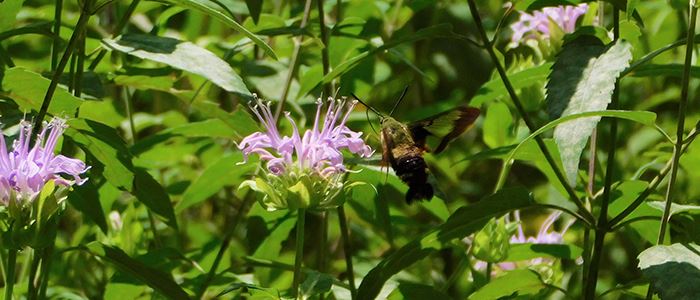Remarkable Pollinators: Part 1

Remarkable Pollinators: Part 1: Clearwing Moths
By: Ashley Fink, Liz Stahl and Karen Menard
Pollinators are wildlife species such as bees, beetles, moths, wasps, flies and butterflies that transfer pollen from one flower to another. These animals visit plants to drink nectar or actually feed on the pollen itself; and then while moving to other blooms, the pollen grains get a free ride.
Pollinators are extremely important because they provide critical services to us and our ecosystems. Their actions result in abundant food sources for humans and other animals. In fact, they are responsible for the availability of about one out of every three bites of our favorite foods and are essential in supporting our ecosystems by helping plants reproduce.
If you have native bergamot (Monarda fistulosa) growing in your yard (pictured above), milkweed, phlox or thistle, you may easily catch a glimpse of a remarkable pollinator called a “clearwing moth.” There are two species of these moths that reside in northwest Ohio- the Snowberry Clearwing (Hemaris diffinis) and the Hummingbird Clearwing (Hemaris thysbe), and they can both be easily viewed this time of year when many of the prairie plants are in bloom.
These moths are often confused with our native Ruby-Throated Hummingbird or with large bumblebees and are actually members of the Sphinx moth family. Caterpillars dine on plants like snowberry, honeysuckle, dogbane and members of the rose family.
If you are close enough, you may hear the soft hum that these animals create, similar to that of a hummingbird. These moths will mostly hover with rapidly beating wings and use their tongue, (or proboscis) to sip nectar, which is similar to hummingbird behavior. As they sip, pollen is transferred onto the moth and then on to the next bloom.
Viewing clearwing moths in the summer is easy in the Metroparks. Just choose a trail at Side Cut Metropark, Oak Openings Preserve, Secor, Wildwood or wherever the wild bergamot is in bloom on a sunny day. Walk slowly and watch. Check your yard, as well. They also frequent urban neighborhoods and gardens, so they may even be flying right outside your back door. Consider planting native plants to attract them if you haven’t already.
Always keep in mind that remarkable pollinators like these moths are indicators of healthy ecosystems that support biodiversity and also essential habitat components that all of us rely on.
Did you know: 75-95% (180,000 species) of all flowering plants on earth rely on pollinators!
Photo and video by Liz Stahl
For more information on pollinators:
https://www.nrcs.usda.gov/wps/portal/nrcs/detail/pa/plantsanimals/?cid=nrcs142p2_018171